Gas boiler with an electric generator: device, principle of operation, an overview of the best brands
A careful attitude to energy resources is dictated primarily by the fact that almost all natural resources are not infinite. The economical use of all types of fuel requires the development of new systems or a radical modernization of existing ones.
So, a gas boiler with an electric generator is one of the types of hybrid systems that make it possible to intelligently dispose of blue fuel. We will introduce you to the principle of operation of equipment that generates electrical energy along with thermal energy. We will present typical models of hybrid units.
The content of the article:
Efficient energy consumption
Even an ordinary man in the street who has a gas boiler installed for heating homes may wonder about the rationality of using thermal energy. Indeed, after all, when burning gas in a boiler, far from all the generated heat is used.
Always when the heating system is working, some of the heat is irretrievably lost. This usually happens when the combustion products are emitted from the boiler into the atmosphere. In fact, this is a lost energy that could be used.
What exactly is it about? About the possibility of wasted heat being used in the production of electric energy in vain.
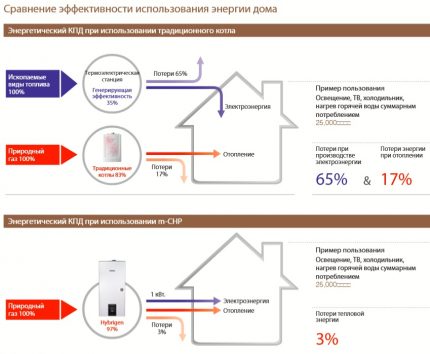
Types of fuel can be different, starting from banal firewood and all kinds of briquettes, ending with the most economical options: main gas with a predominance of methane in the composition, artificial blue fuel and propane-butane liquefied mixtures.
It may seem that this is far from the “discovery of America”, but actually the technology developed back in 1943 by Robert Stirling, or rather, the installation exists. Its design features and the basic principle of operation allows us to attribute this system to internal combustion engines.
Why, then, did not use this installation for such a considerable time? The answer is simple - the theoretical development of technology in the forties of the last century turned out to be very cumbersome in practice.
The technologies and materials that existed at the time of development did not allow reducing the size of the installation, and the existing methods for generating electric energy were more cost-effective.
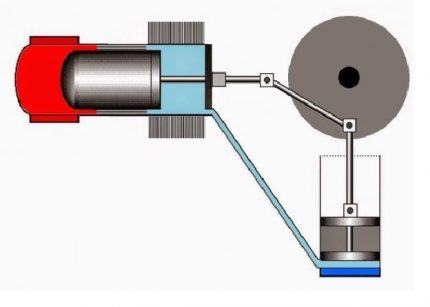
What can make us today think about a more careful attitude to resources that are not classified as renewable? Now there is a common problem all over the world - the development of technologies will inevitably lead to an increase in the consumption of electric energy.
The increase in consumption is taking place at such a rapid pace that the grid companies do not have time to modernize the transmission systems of electric energy, not to mention production. This situation inevitably leads to the fact that the elements of power supply systems fail, and in some cases this can happen with enviable regularity.
Modern heating boilers are equipped with control systems that are also volatile. The circulation pump, sensors, automation, the panel itself need electric power. The entire set of devices cannot but cause an alarm for maintaining operability during a power outage.
Forced heating systems cannot be started without electricity. Turning off the power during the heating season is almost disastrous for them. Not only that, this will inevitably lead to rapid cooling of the room, with long-term idle heating, the circuit can freeze.
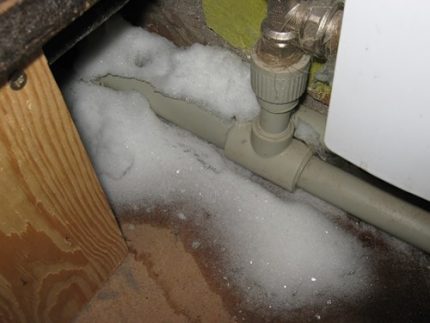
Standard existing solutions to the issue - installation uninterruptible power suppliesgenerators of all kinds of modifications (gas, benzo, diesel generators or non-traditional sources - wind generators or mini TPPs, hydroelectric power stations).
But this solution is far from acceptable for everyone, since many people find it difficult to allocate space for installing an autonomous electricity supplier.
If residents of individual houses can still allocate space for a generator, then for installation in a multi-storey building it is almost impossible. Thus, it turns out that residents of apartment buildings with individual heating systems are the first to suffer when the lights are turned off.
That is why, first of all, companies that produce components for assembling heating systems wondered about the full use of heat, which is "emitted" by the heating system. We thought about how to use the useless substance in the generation of electricity.
From well-known technologies, the developers chose the “well-forgotten” Stirling unit; modern technologies allow increasing its efficiency, while maintaining compact dimensions.

The principle of operation of the Stirling unit is based on the use of heating and cooling of the working fluid, which in turn drives a mechanism that generates electrical energy.
Injected gas is located inside the piston (closed), when heated, the gaseous medium expands and moves the piston in one direction, after cooling in the cooler it is compressed and moves the piston in the other direction.
Overview of manufacturers of boilers with a generator
Let's look at specific examples of the system of domestic boilers that exist today, in which the principle of using exhaust gases (combustion products) for the production of electricity has been successfully implemented. The South Korean company NAVIEN has successfully implemented the above technology in a boiler of the brand HYBRIGEN SE.
The boiler uses a Stirling engine, which, according to the passport data, generates electricity with a capacity of 1000W (or 1kW) and a voltage of 12V during operation. The developers claim that the generated electricity can be used to power household appliances.
Such power should be enough to power a domestic refrigerator (about 0.1 kW), a personal computer (about 0.4 kW), an LCD TV (about 0.2 kW) and up to 12 LED bulbs with a power of 25 watts each.
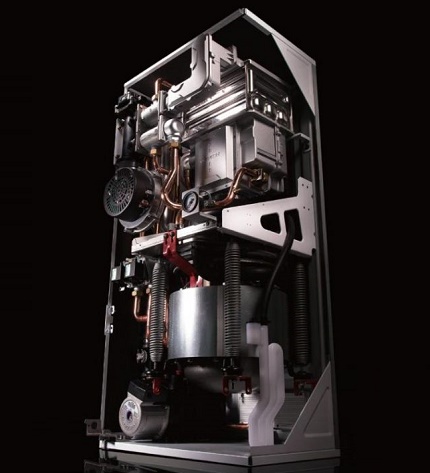
From European manufacturers, Viessmann is engaged in development in this area. Viessmann has the opportunity to present two models of the Vitotwin 300W and Vitotwin 350F series boilers to the consumer's choice.
The Vitotwin 300W was the first development in this direction. It has a fairly compact design and looks very similar to the usual wall mounted gas boiler. True, it was during the operation of the first model that the "weak" spots in the operation of the Stirling system engine were identified.
The biggest problem was the removal of heat, the basis of the device is heating and cooling. Those. the developers faced the same problem that Stirling faced in the forties of the last century - efficient cooling, which can be achieved only with significant sizes of the cooler.
That is why the Vitotwin 350F boiler model appeared, which included not only a gas boiler with an electricity generator, but also an integrated 175 liter boiler.
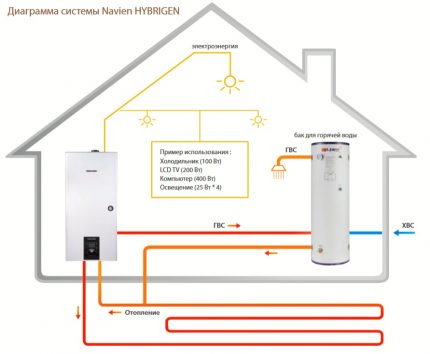
In this case, the problem with the problem of cooling the piston of the Stirling unit due to water in boiler. However, the decision led to the fact that the overall dimensions and weight of the installation increased. Such a system can no longer be mounted on the wall like an ordinary gas boiler and can only be floor mounted.
Viessmann boilers provide the possibility of feeding the boiler operation systems from an external source, i.e. from central power supply networks. Viessmann positioned the equipment as a device providing its own needs (operation of boiler units) without the possibility of selecting excess electricity for domestic consumption.
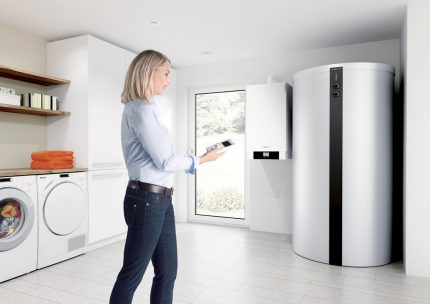
In order to be able to compare the effectiveness of the use of generators built into the heating system. It is worth considering the boiler, which was developed by the TERMOFOR companies (Republic of Belarus) and the Krioterm company (Russia, St. Petersburg).
It is worth considering them not because they can somehow compete with the above systems, but to compare the principles of operation and the efficiency of generating electrical energy. These boilers use only firewood as fuel pressed sawdust or briquettes based on wood, so they can not be put on a par with the models of NAVIEN and Viessmann.
The boiler, called "Indigirka Heating Furnace", is focused on long-term heating with wood, etc., but is equipped with two thermal electricity generators of the TEG 30-12 type. They are located on the side wall of the unit. The power of the generators is small, i.e.in total, they are able to generate only 50-60W with a voltage of 12V.
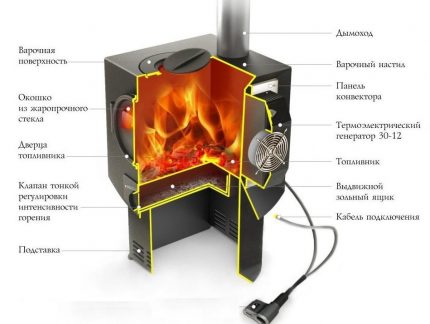
In this boiler, the Zebek method has been used, based on the formation of an EMF in a closed electrical circuit. It consists of two dissimilar types of material and maintains contact points at different temperatures. Those. developers also use the heat generated by the boiler to generate electrical energy.
Comparison of boiler performance
Comparing the presented types of boilers, which not only heat the room (heat coolant), but also generate electricity through the use of generated heat, attention should be paid to important aspects during operation.
Both NAVIEN and Viessmann are positioning their boilers, indicating undoubted advantages - complete automation of the process, the absence of the need for service repairs and the complete absence of interference after commissioning by the buyer.
For the operation of these boilers, only stable operation of the system is necessary; stable gas availability (whether it is trunk deliveries, a cylinder installation with liquefied gas or gas tank) Accordingly, for the operation of boilers, household gas is used, which after combustion does not pose any harm to the environment.
In principle, almost the same can be said about the Indigirka heating stove, only the type of fuel here is not gas, but firewood, pellets or pressed sawdust.
Complete absence automaticswhich requires electricity. The system for generating electric energy and the boiler itself does not affect the operation of each other, i.e. in case of failure of the power generation system, the boiler continues to perform its functions.

NAVIEN and Viessmann boilers will not be able to boast of such, since the Stirling system engine is built directly into the boiler design. But how cost-effective are such systems and after how long will a similar boiler pay off? This issue should be dealt with in detail.
Profitability of the considered systems
At first glance, the boilers of NAVIEN and Viessmann are almost mini-thermal power plants in a private house or even apartment.
Even despite the large overall dimensions, the ability to produce electrical energy simply by using a boiler to heat a boiler or to heat rooms should prompt the buyer without hesitation to establish such a “miracle of technology”.
But upon closer inspection of the NAVIEN boiler, questions arise that need to be answered. With a declared power of 1 kW (free power, which you can use at your discretion), the boiler consumes electricity quite noticeably when the system is running.
What is meant? At least the operation of automation, even if a little power is needed, but it is needed in order for the fan and circulation pump to function. The listed devices in total can not only successfully consume this kilowatt of energy, but it may not be enough when the system is “dispersed”.

The exact same questions arise with Viessmann boilers, but at least the possibility of extracting electricity for one’s own needs was not stated here. Only the possibility of autonomous operation of the system in the absence of external supply was stipulated.
Although developers immediately indicate that "the system may require additional electrical power at peak loads." Against the background of the claimed 3500 kWh of generated electricity per year, this nuance is already in doubt, and through simple and uncomplicated calculations we get the following:
3500: 6 (months of the standard heating season): 30 (30 calendar days on average): 24 (24 hours in a day) = 0.81 kW * hour.
Those. The boiler produces about 800W with stable (constant) operation, but how much does the system itself consume during operation? Perhaps the same ones produced by 800W, and possibly more.
In addition, electricity is generated only during the operation of the burner. Those. It requires either continuous operation of the system, or everything is a little different than the developers of the system say.
What did these calculations lead to? The wood-fired boiler system really gives its 50W * h (or 0.05 kW * h), which can be used to recharge a tablet, phone, etc. even for the banal "standby LED light bulb." In contrast to the development of two world-famous companies, but the described development clearly looks more like a good marketing move, and nothing more.
As for the pricing policy for these systems, it is generally difficult to evaluate something here. Since even manufacturers Viessmann and NAVIEN immediately stipulate that the equipment "does not require maintenance." Translated into a simple language - it broke, which means that you need to replace the unit completely.
This may concern not only the entire system, but individual units: the Stirling engine, gas burner system, etc. The result is a fairly impressive amount. Based on the fact that the average price for these systems is about 12 thousand. Euro or 13.5 thousand $. The scheme of the boiler with the generator, then the manufacturer of systems can win in such a situation.
The Indigirka stove cannot participate in the comparison at all, not only because the type of fuel is not gas, and the price is not comparable (15 times less), but because the stove is not positioned for domestic use, but more for travel, expeditions, etc. .P.
If in Europe the situation with energy carriers significantly influences the choice of consumers (when choosing heating or energy supply systems) from the point of view of efficiency and environmental friendliness, then EU states stimulate this by subsidizing the implementation of such systems.
For the domestic consumer in Russia, such systems are likely to be too expensive both initially “system + installation” and during operation.
Conclusions and useful video on the topic
The principle of operation of the Stirling engine, equipping a gas boiler:
Demonstration of the gas boiler with an electricity generator:
An example of a wood stove with an electricity generator for comparison with a gas unit:
Do not forget that European energy-generating companies are quite loyal to the “manufacturers” of energy-saving equipment.
In Russia, the possibility of generating and transmitting electric energy to the grid by a household consumer is not only not fixed by law, but also not welcomed by grid companies. Therefore, the presented systems are unlikely to have serious chances of being used in the Russian Federation today.
Please comment on the article submitted for consideration in the block form below, ask questions, post a photo on the topic. Tell us about boilers familiar with power generating systems. Share useful information that is useful to site visitors.

 Hydrogen heating boiler: device + principle of operation + selection criteria
Hydrogen heating boiler: device + principle of operation + selection criteria  Gas boiler for liquefied gas: operating principle, types, how to choose the right + manufacturers rating
Gas boiler for liquefied gas: operating principle, types, how to choose the right + manufacturers rating 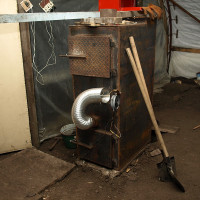 Do-it-yourself pyrolysis boiler: device, circuits, principle of operation
Do-it-yourself pyrolysis boiler: device, circuits, principle of operation  Automation for gas heating boilers: device, principle of operation, manufacturers overview
Automation for gas heating boilers: device, principle of operation, manufacturers overview 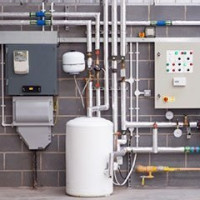 How to choose the best gas boiler: an overview of the criteria for choosing the best unit
How to choose the best gas boiler: an overview of the criteria for choosing the best unit 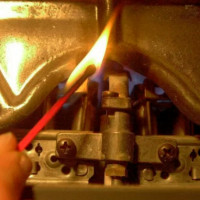 Why does the gas boiler go out? Overview of typical faults and how to solve them
Why does the gas boiler go out? Overview of typical faults and how to solve them  How much does it cost to connect gas to a private house: the price of organizing gas supply
How much does it cost to connect gas to a private house: the price of organizing gas supply  The best washing machines with dryer: model rating and customer tips
The best washing machines with dryer: model rating and customer tips  What is the color temperature of light and the nuances of choosing the temperature of the lamps to suit your needs
What is the color temperature of light and the nuances of choosing the temperature of the lamps to suit your needs  Replacement of a geyser in an apartment: replacement paperwork + basic norms and requirements
Replacement of a geyser in an apartment: replacement paperwork + basic norms and requirements